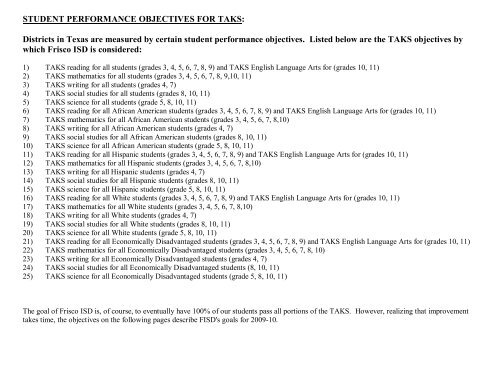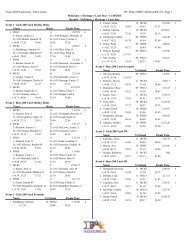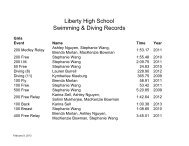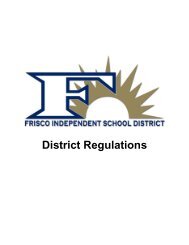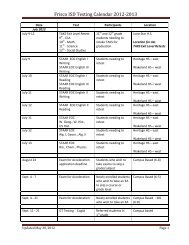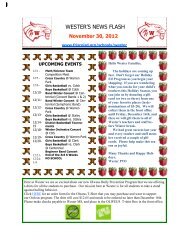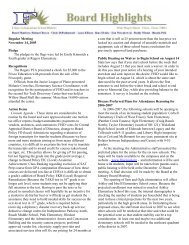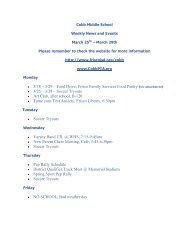STUDENT PERFORMANCE OBJECTIVES FOR TAKS ... - Frisco ISD
STUDENT PERFORMANCE OBJECTIVES FOR TAKS ... - Frisco ISD
STUDENT PERFORMANCE OBJECTIVES FOR TAKS ... - Frisco ISD
Create successful ePaper yourself
Turn your PDF publications into a flip-book with our unique Google optimized e-Paper software.
<strong>STUDENT</strong> <strong>PER<strong>FOR</strong>MANCE</strong> <strong>OBJECTIVES</strong> <strong>FOR</strong> <strong>TAKS</strong>:<br />
Districts in Texas are measured by certain student performance objectives. Listed below are the <strong>TAKS</strong> objectives by<br />
which <strong>Frisco</strong> <strong>ISD</strong> is considered:<br />
1) <strong>TAKS</strong> reading for all students (grades 3, 4, 5, 6, 7, 8, 9) and <strong>TAKS</strong> English Language Arts for (grades 10, 11)<br />
2) <strong>TAKS</strong> mathematics for all students (grades 3, 4, 5, 6, 7, 8, 9,10, 11)<br />
3) <strong>TAKS</strong> writing for all students (grades 4, 7)<br />
4) <strong>TAKS</strong> social studies for all students (grades 8, 10, 11)<br />
5) <strong>TAKS</strong> science for all students (grade 5, 8, 10, 11)<br />
6) <strong>TAKS</strong> reading for all African American students (grades 3, 4, 5, 6, 7, 8, 9) and <strong>TAKS</strong> English Language Arts for (grades 10, 11)<br />
7) <strong>TAKS</strong> mathematics for all African American students (grades 3, 4, 5, 6, 7, 8,10)<br />
8) <strong>TAKS</strong> writing for all African American students (grades 4, 7)<br />
9) <strong>TAKS</strong> social studies for all African American students (grades 8, 10, 11)<br />
10) <strong>TAKS</strong> science for all African American students (grade 5, 8, 10, 11)<br />
11) <strong>TAKS</strong> reading for all Hispanic students (grades 3, 4, 5, 6, 7, 8, 9) and <strong>TAKS</strong> English Language Arts for (grades 10, 11)<br />
12) <strong>TAKS</strong> mathematics for all Hispanic students (grades 3, 4, 5, 6, 7, 8,10)<br />
13) <strong>TAKS</strong> writing for all Hispanic students (grades 4, 7)<br />
14) <strong>TAKS</strong> social studies for all Hispanic students (grades 8, 10, 11)<br />
15) <strong>TAKS</strong> science for all Hispanic students (grade 5, 8, 10, 11)<br />
16) <strong>TAKS</strong> reading for all White students (grades 3, 4, 5, 6, 7, 8, 9) and <strong>TAKS</strong> English Language Arts for (grades 10, 11)<br />
17) <strong>TAKS</strong> mathematics for all White students (grades 3, 4, 5, 6, 7, 8,10)<br />
18) <strong>TAKS</strong> writing for all White students (grades 4, 7)<br />
19) <strong>TAKS</strong> social studies for all White students (grades 8, 10, 11)<br />
20) <strong>TAKS</strong> science for all White students (grade 5, 8, 10, 11)<br />
21) <strong>TAKS</strong> reading for all Economically Disadvantaged students (grades 3, 4, 5, 6, 7, 8, 9) and <strong>TAKS</strong> English Language Arts for (grades 10, 11)<br />
22) <strong>TAKS</strong> mathematics for all Economically Disadvantaged students (grades 3, 4, 5, 6, 7, 8, 10)<br />
23) <strong>TAKS</strong> writing for all Economically Disadvantaged students (grades 4, 7)<br />
24) <strong>TAKS</strong> social studies for all Economically Disadvantaged students (8, 10, 11)<br />
25) <strong>TAKS</strong> science for all Economically Disadvantaged students (grade 5, 8, 10, 11)<br />
The goal of <strong>Frisco</strong> <strong>ISD</strong> is, of course, to eventually have 100% of our students pass all portions of the <strong>TAKS</strong>. However, realizing that improvement<br />
takes time, the objectives on the following pages describe F<strong>ISD</strong>'s goals for 200910.
<strong>STUDENT</strong> <strong>PER<strong>FOR</strong>MANCE</strong> <strong>OBJECTIVES</strong>:<br />
READING/ENGLISH LANGUAGE ARTS ALL <strong>STUDENT</strong>S<br />
1. The percent of F<strong>ISD</strong> third grade students passing the <strong>TAKS</strong> Reading test will increase from 97% in Spring, 2009 to 98% in Spring, 2010.<br />
In order to maintain 100% of students meeting minimum expectations on this objective by 20132014, the passing rate will have to increase<br />
by 0.6 percentage points per year.<br />
2. The percent of F<strong>ISD</strong> fourth grade students passing the <strong>TAKS</strong> Reading test will increase from 96% in Spring, 2009 to 97% in Spring, 2010.<br />
In order to reach 100% of students meeting minimum expectations on this objective by 20132014, the passing rate will have to increase by<br />
0.8 percentage points per year.<br />
3. The percent of F<strong>ISD</strong> fifth grade students passing the <strong>TAKS</strong> Reading test will increase from 99% in Spring, 2009 to 100% in Spring, 2010.<br />
In order to reach 100% of students meeting minimum expectations on this objective by 20132014, the passing rate will have to increase by<br />
0.2 percentage point per year.<br />
4. The percent of F<strong>ISD</strong> sixth grade students passing the <strong>TAKS</strong> Reading test will increase from 98% in Spring, 2009 to 99% in Spring, 2010.<br />
In order to reach 100% of students meeting minimum expectations on this objective by 20132014, the passing rate will have to increase by<br />
0.4 percentage points per year.<br />
5. The percent of F<strong>ISD</strong> seventh grade students passing the <strong>TAKS</strong> Reading test will increase from 96% in Spring, 2009 to 97% in Spring, 2010.<br />
In order to reach 100% of students meeting minimum expectations on this objective by 20132014, the passing rate will have to increase by<br />
0.8 percentage points per year.<br />
6. The percent of F<strong>ISD</strong> eighth grade students passing the <strong>TAKS</strong> Reading test will maintain 100% in Spring, 2010.<br />
7. The percent of F<strong>ISD</strong> ninth grade students passing the <strong>TAKS</strong> Reading test will increase from 98% in Spring, 2009 to 99% in Spring, 2010.<br />
In order to reach 100% of students meeting minimum expectations on this objective by 20132014, the passing rate will have to increase by<br />
0.4 percentage points per year.<br />
8. The percent of F<strong>ISD</strong> tenth grade students passing the <strong>TAKS</strong> English Language Arts test will increase from 97% in Spring, 2009 to 98% in<br />
Spring, 2010. In order to reach 100% of students meeting minimum expectations on this objective by 20132014, the passing rate will have to<br />
increase by 0.6 percentage points per year.<br />
9. The percent of F<strong>ISD</strong> eleventh grade students passing the <strong>TAKS</strong> English Language Arts test will increase from 98% in Spring, 2009 to 99%<br />
in Spring, 2010. In order to reach 100% of students meeting minimum expectations on this objective by 20132014, the passing rate will<br />
have to increase by 0.4 percentage points per year.
<strong>STUDENT</strong> <strong>PER<strong>FOR</strong>MANCE</strong> <strong>OBJECTIVES</strong>:<br />
MATHEMATICS ALL <strong>STUDENT</strong>S<br />
1. The percent of F<strong>ISD</strong> third grade students passing the <strong>TAKS</strong> Mathematics test will increase from 95% in Spring, 2009 to 96% in Spring, 2010.<br />
In order to reach 100% of students meeting minimum expectations on this objective by 20132014, the passing rate will have to increase by<br />
1.0 percentage points per year.<br />
2. The percent of F<strong>ISD</strong> fourth grade students passing the <strong>TAKS</strong> Mathematics test will increase from 97% in Spring, 2009 to 98% in Spring,<br />
2010. In order to reach 100% of students meeting minimum expectations on this objective by 20132014, the passing rate will have to<br />
increase by 0.6 percentage points per year.<br />
3. The percent of F<strong>ISD</strong> fifth grade students passing the <strong>TAKS</strong> Mathematics test will increase from 99% in Spring, 2009 to 100% in Spring, 2010<br />
In order to reach 100% of students meeting minimum expectations on this objective by 20132014, the passing rate will have to increase<br />
by 0.2 percentage point per year.<br />
4. The percent of F<strong>ISD</strong> sixth grade students passing the <strong>TAKS</strong> Mathematics test will increase from 95% in Spring, 2009 to 96% in Spring, 2010.<br />
In order to reach 100% of students meeting minimum expectations on this objective by 20132014, the passing rate will have to<br />
increase by 1.0 percentage points per year.<br />
5. The percent of F<strong>ISD</strong> seventh grade students passing the <strong>TAKS</strong> Mathematics test will increase from 96% in Spring, 2009 to 97% in Spring,<br />
2010. In order to reach 100% of students meeting minimum expectations on this objective by 20132014, the passing rate will have to<br />
increase by 0.8 percentage points per year.<br />
6. The percent of F<strong>ISD</strong> eighth grade students passing the <strong>TAKS</strong> Mathematics test will increase from 98% in Spring, 2009 to 99% in Spring,<br />
2010. In order to reach 100% of students meeting minimum expectations on this objective by 20132014, the passing rate will have to<br />
increase by 0.4 percentage points per year.<br />
7. The percent of F<strong>ISD</strong> ninth grade students passing the <strong>TAKS</strong> Mathematics test will increase from 90% in Spring, 2009 to 92% in Spring,<br />
2010. In order to reach 100% of students meeting minimum expectations on this objective by 20132014, the passing rate will have to<br />
increase by 2.0 percentage points per year.<br />
8. The percent of F<strong>ISD</strong> tenth grade students passing the <strong>TAKS</strong> Mathematics test will increase from 85% in Spring, 2009 to 86% in Spring, 2010.<br />
In order to reach 90% of students meeting minimum expectations on this objective by 20132014, the passing rate will have to<br />
increase by 1.0 percentage points per year.<br />
9. The percent of F<strong>ISD</strong> eleventh grade students passing the <strong>TAKS</strong> Mathematics test will increase from 95% in Spring, 2009 to 96% in Spring,<br />
2010. In order to reach 100% of students meeting minimum expectations on this objective by 20132014, the passing rate will have to<br />
increase by 1.0 percentage points per year.
<strong>STUDENT</strong> <strong>PER<strong>FOR</strong>MANCE</strong> <strong>OBJECTIVES</strong>:<br />
WRITING ALL <strong>STUDENT</strong>S<br />
1. The percent of F<strong>ISD</strong> fourth grade students passing the <strong>TAKS</strong> Writing test will increase from 97% in Spring, 2009 to 98% in Spring, 2010.<br />
In order to reach 100% of students meeting minimum expectations on this objective by 20132014, the passing rate will have to increase by<br />
0.6 percentage points per year.<br />
2. The percent of F<strong>ISD</strong> seventh grade students passing the <strong>TAKS</strong> Writing test will increase from 98% in Spring, 2009 to 99% in Spring, 2010.<br />
In order to reach 100% of students meeting minimum expectations on this objective by 20132014, the passing rate will have to increase by<br />
0.4 percentage points per year.
<strong>STUDENT</strong> <strong>PER<strong>FOR</strong>MANCE</strong> <strong>OBJECTIVES</strong>:<br />
SOCIAL STUDIES ALL <strong>STUDENT</strong>S<br />
1. The percent of F<strong>ISD</strong> eighth grade students passing the <strong>TAKS</strong> Social Studies test will increase from 98% in Spring, 2009 to 99% in Spring,<br />
2010. In order to maintain 100% of students meeting minimum expectations on this objective by 20132014, the passing rate will have to<br />
increase by 0.4 percentage points per year.<br />
2. The percent of F<strong>ISD</strong> tenth grade students passing the <strong>TAKS</strong> Social Studies test will increase from 98% in Spring, 2009 to 99% in Spring,<br />
2010. In order to reach 100% of students meeting minimum expectations on this objective by 20132014, the passing rate will have to<br />
increase by 0.4 percentage points per year.<br />
3. The percent of F<strong>ISD</strong> eleventh grade students passing the <strong>TAKS</strong> Social Studies test will maintain 100% in Spring, 2010.
<strong>STUDENT</strong> <strong>PER<strong>FOR</strong>MANCE</strong> <strong>OBJECTIVES</strong>:<br />
SCIENCE ALL <strong>STUDENT</strong>S<br />
1. The percent of F<strong>ISD</strong> fifth grade students passing the <strong>TAKS</strong> Science test will increase from 96% in Spring, 2009 to 97% in Spring, 2010.<br />
In order to reach 100% of students meeting minimum expectations on this objective by 20132014, the passing rate will have to increase by<br />
0.8 percentage points per year.<br />
2. The percent of F<strong>ISD</strong> eighth grade students passing the <strong>TAKS</strong> Science test will increase from 91% in Spring, 2009 to 93% in Spring, 2010.<br />
In order to reach 100% of students meeting minimum expectations on this objective by 20132014, the passing rate will have to increase by<br />
1.8 percentage points per year.<br />
3. The percent of F<strong>ISD</strong> tenth grade students passing the <strong>TAKS</strong> Science test will increase from 88% in Spring, 2009 to 89% in Spring, 2010.<br />
In order to reach 90% of students meeting minimum expectations on this objective by 20132014, the passing rate will have to increase by<br />
0.4 percentage points per year.<br />
4. The percent of F<strong>ISD</strong> eleventh grade students passing the <strong>TAKS</strong> Science test will increase from 97% in Spring, 2009 to 98% in Spring,<br />
2010. In order to reach 100% of students meeting minimum expectations on this objective by 20132014, the passing rate will have to<br />
increase by 0.6 percentage points per year.
<strong>STUDENT</strong> <strong>PER<strong>FOR</strong>MANCE</strong> <strong>OBJECTIVES</strong>:<br />
READING/ENGLISH LANGUAGE ARTS AFRICANAMERICAN <strong>STUDENT</strong>S<br />
1. The percent of F<strong>ISD</strong> AfricanAmerican third grade students passing the <strong>TAKS</strong> Reading test will maintain 100% in Spring, 2010.<br />
2. The percent of F<strong>ISD</strong> AfricanAmerican fourth grade students passing the <strong>TAKS</strong> Reading test will increase from 90% in Spring, 2009 to 92%<br />
in Spring, 2010. In order to reach 100% of students meeting minimum expectations on this objective by 20132014, the passing rate will have<br />
to increase by 2.0 percentage points per year.<br />
3. The percent of F<strong>ISD</strong> AfricanAmerican fifth grade students passing the <strong>TAKS</strong> Reading test will increase from 98% in Spring, 2009 to 99%<br />
in Spring, 2010. In order to reach 100% of students meeting minimum expectations on this objective by 20132014, the passing rate will<br />
have to increase by 0.4 percentage point per year.<br />
4. The percent of F<strong>ISD</strong> AfricanAmerican sixth grade students passing the <strong>TAKS</strong> Reading test will increase from 95% in Spring, 2009 to 96%<br />
in Spring, 2010. In order to reach 100% of students meeting minimum expectations on this objective by 20132014, the passing rate will<br />
have to increase by 1.0 percentage points per year.<br />
5. The percent of F<strong>ISD</strong> AfricanAmerican seventh grade students passing the <strong>TAKS</strong> Reading test will increase from 91% in Spring, 2009 to<br />
93% in Spring, 2010. In order to reach 100% of students meeting minimum expectations on this objective by 20132014, the passing rate<br />
will have to increase by 1.8 percentage points per year.<br />
6. The percent of F<strong>ISD</strong> AfricanAmerican eighth grade students passing the <strong>TAKS</strong> Reading test will increase from 99% in Spring, 2009 to<br />
100% in Spring, 2010. In order to reach 100% of students meeting minimum expectations on this objective by 20132014, the passing rate<br />
will have to increase by 0.2 percentage points per year.<br />
7. The percent of F<strong>ISD</strong> AfricanAmerican ninth grade students passing the <strong>TAKS</strong> Reading test will increase from 95% in Spring, 2009 to 96%<br />
in Spring, 2010. In order to reach 100% of students meeting minimum expectations on this objective by 20132014, the passing rate will<br />
have to increase by 1.0 percentage points per year.<br />
8. The percent of F<strong>ISD</strong> AfricanAmerican tenth grade students passing the <strong>TAKS</strong> English Language Arts test will increase from 93% in Spring,<br />
2009 to 94% in Spring, 2010. In order to reach 100% of students meeting minimum expectations on this objective by 20132014, the passing<br />
rate will have to increase by 1.4 percentage points per year.<br />
9. The percent of F<strong>ISD</strong> AfricanAmerican eleventh grade students passing the <strong>TAKS</strong> English Language Arts test will increase from 96% in<br />
Spring, 2009 to 97% in Spring, 2010. In order to reach 100% of students meeting minimum expectations on this objective by 20132014,<br />
the passing rate will have to increase by 0.8 percentage points per year.
<strong>STUDENT</strong> <strong>PER<strong>FOR</strong>MANCE</strong> <strong>OBJECTIVES</strong>:<br />
MATHEMATICS AFRICANAMERICAN <strong>STUDENT</strong>S<br />
1. The percent of F<strong>ISD</strong> AfricanAmerican third grade students passing the <strong>TAKS</strong> Mathematics test will increase from 87% in Spring, 2009 to<br />
88% in Spring, 2010. In order to reach 90% of students meeting minimum expectations on this objective by 20132014, the passing rate<br />
will have to increase by 0.6 percentage points per year.<br />
2. The percent of F<strong>ISD</strong> AfricanAmerican fourth grade students passing the <strong>TAKS</strong> Mathematics test will increase from 93% in Spring, 2009 to<br />
94% in Spring, 2010. In order to reach 100% of students meeting minimum expectations on this objective by 20132014, the passing rate<br />
will have to increase by 1.4 percentage points per year.<br />
3. The percent of F<strong>ISD</strong> AfricanAmerican fifth grade students passing the <strong>TAKS</strong> Mathematics test will increase from 97% in Spring, 2009 to<br />
98% in Spring, 2010. In order to reach 100% of students meeting minimum expectations on this objective by 20132014, the passing rate<br />
will have to increase by 0.6 percentage points per year.<br />
4. The percent of F<strong>ISD</strong> AfricanAmerican sixth grade students passing the <strong>TAKS</strong> Mathematics test will increase from 90% in Spring, 2009 to<br />
92% in Spring, 2010. In order to reach 100% of students meeting minimum expectations on this objective by 20132014, the passing rate will<br />
have to increase by 2.0 percentage points per year.<br />
5. The percent of F<strong>ISD</strong> AfricanAmerican seventh grade students passing the <strong>TAKS</strong> Mathematics test will increase from 90% in Spring, 2009<br />
to 92% in Spring, 2010. In order to reach 100% of students meeting minimum expectations on this objective by 20132014, the passing rate<br />
will have to increase by 2.0 percentage points per year.<br />
6. The percent of F<strong>ISD</strong> AfricanAmerican eighth grade students passing the <strong>TAKS</strong> Mathematics test will increase from 94% in Spring, 2009 to<br />
95% in Spring, 2010. In order to reach 100% of students meeting minimum expectations on this objective by 20132014, the passing rate<br />
will have to increase by 1.2 percentage points per year.<br />
7. The percent of F<strong>ISD</strong> AfricanAmerican ninth grade students passing the <strong>TAKS</strong> Mathematics test will increase from 81% in Spring, 2009 to<br />
83% in Spring, 2010. In order to reach 90% of students meeting minimum expectations on this objective by 20132014, the passing rate will<br />
have to increase by 1.8 percentage points per year.<br />
8. The percent of F<strong>ISD</strong> AfricanAmerican tenth grade students passing the <strong>TAKS</strong> Mathematics test will increase from 71% in Spring, 2009 to<br />
73% in Spring, 2010. In order to reach 80% of students meeting minimum expectations on this objective by 20132014, the passing rate will<br />
have to increase by 1.8 percentage points per year.<br />
9. The percent of F<strong>ISD</strong> AfricanAmerican eleventh grade students passing the <strong>TAKS</strong> Mathematics test will increase from 87% in Spring, 2009<br />
to 88% in Spring, 2010. In order to reach 90% of students meeting minimum expectations on this objective by 20132014, the passing rate<br />
will have to increase by 0.6 percentage points per year.
<strong>STUDENT</strong> <strong>PER<strong>FOR</strong>MANCE</strong> <strong>OBJECTIVES</strong>:<br />
WRITING AFRICANAMERICAN <strong>STUDENT</strong>S<br />
1. The percent of F<strong>ISD</strong> AfricanAmerican fourth grade students passing the <strong>TAKS</strong> Writing test will increase from 96% in Spring, 2009 to 97%<br />
in Spring, 2010. In order to reach 100% of students meeting minimum expectations on this objective by 20132014, the passing rate will<br />
have to increase by 0.8 percentage points per year.<br />
2. The percent of F<strong>ISD</strong> AfricanAmerican seventh grade students passing the <strong>TAKS</strong> Writing test will increase from 98% in Spring, 2009 to<br />
99% in Spring, 2010. In order to reach 100% of students meeting minimum expectations on this objective by 20132014, the passing rate will<br />
have to increase by 0.4 percentage points per year.
<strong>STUDENT</strong> <strong>PER<strong>FOR</strong>MANCE</strong> <strong>OBJECTIVES</strong>:<br />
SOCIAL STUDIES AFRICANAMERICAN <strong>STUDENT</strong>S<br />
1. The percent of F<strong>ISD</strong> AfricanAmerican eighth grade students passing the <strong>TAKS</strong> Social Studies test will increase from 97% in Spring, 2009<br />
to 98% in Spring, 2010. In order to reach 100% of students meeting minimum expectations on this objective by 20132014, the passing rate<br />
will have to increase by 0.6 percentage points per year.<br />
2. The percent of F<strong>ISD</strong> AfricanAmerican tenth grade students passing the <strong>TAKS</strong> Social Studies test will increase from 96% in Spring, 2009 to<br />
97% in Spring, 2010. In order to reach 100% of students meeting minimum expectations on this objective by 20132014, the passing rate will<br />
have to increase by 0.8 percentage points per year.<br />
3. The percent of F<strong>ISD</strong> AfricanAmerican eleventh grade students passing the <strong>TAKS</strong> Social Studies test will maintain 100% in Spring, 2010.
<strong>STUDENT</strong> <strong>PER<strong>FOR</strong>MANCE</strong> <strong>OBJECTIVES</strong>:<br />
SCIENCE AFRICANAMERICAN <strong>STUDENT</strong>S<br />
1. The percent of F<strong>ISD</strong> AfricanAmerican fifth grade students passing the <strong>TAKS</strong> Science test will increase from 90% in Spring, 2009 to 92%<br />
in Spring, 2010. In order to reach 100% of students meeting minimum expectations on this objective by 20132014, the passing rate will have<br />
to increase by 2.0 percentage points per year.<br />
2. The percent of F<strong>ISD</strong> AfricanAmerican eighth grade students passing the <strong>TAKS</strong> Science test will increase from 77% in Spring, 2009 to 78%<br />
in Spring, 2010. In order to reach 80% of students meeting minimum expectations on this objective by 20132014, the passing rate will<br />
have to increase by 0.6 percentage points per year.<br />
3. The percent of F<strong>ISD</strong> AfricanAmerican tenth grade students passing the <strong>TAKS</strong> Science test will increase from 73% in Spring, 2009 to 74%<br />
in Spring, 2010. In order to reach 80% of students meeting minimum expectations on this objective by 20132014, the passing rate will<br />
have to increase by 1.4 percentage points per year.<br />
4. The percent of F<strong>ISD</strong> AfricanAmerican eleventh grade students passing the <strong>TAKS</strong> Science test will increase from 93% in Spring, 2009 to<br />
94% in Spring, 2010. In order to reach 100% of students meeting minimum expectations on this objective by 20132014, the passing rate<br />
will have to increase by 1.4 percentage points per year.
<strong>STUDENT</strong> <strong>PER<strong>FOR</strong>MANCE</strong> <strong>OBJECTIVES</strong>:<br />
READING/ENGLISH LANGUAGE ARTS HISPANIC <strong>STUDENT</strong>S<br />
1. The percent of F<strong>ISD</strong> Hispanic third grade students passing the <strong>TAKS</strong> Reading test will increase from 88% in Spring, 2009 to 90% in Spring,<br />
2010. In order to reach 100% of students meeting minimum expectations on this objective by 20132014, the passing rate will have to<br />
increase by 0.4 percentage points per year.<br />
2. The percent of F<strong>ISD</strong> Hispanic fourth grade students passing the <strong>TAKS</strong> Reading test will increase from 92% in Spring, 2009 to 93% in Spring,<br />
2010. In order to reach 100% of students meeting minimum expectations on this objective by 20132014, the passing rate will have to<br />
increase by 1.6 percentage points per year.<br />
3. The percent of F<strong>ISD</strong> Hispanic fifth grade students passing the <strong>TAKS</strong> Reading test will increase from 98% in Spring, 2009 to 99% in Spring,<br />
2010. In order to reach 100% of students meeting minimum expectations on this objective by 20132014, the passing rate will have to<br />
increase by 0.4 percentage point per year.<br />
4. The percent of F<strong>ISD</strong> Hispanic sixth grade students passing the <strong>TAKS</strong> Reading test will increase from 96% in Spring, 2009 to 97% in Spring,<br />
2010. In order to reach 100% of students meeting minimum expectations on this objective by 20132014, the passing rate will have to<br />
increase by 0.8 percentage points per year.<br />
5. The percent of F<strong>ISD</strong> Hispanic seventh grade students passing the <strong>TAKS</strong> Reading test will increase from 94% in Spring, 2009 to 95% in<br />
Spring, 2010. In order to reach 100% of students meeting minimum expectations on this objective by 20132014, the passing rate will have<br />
to increase by 1.2 percentage points per year.<br />
6. The percent of F<strong>ISD</strong> Hispanic eighth grade students passing the <strong>TAKS</strong> Reading test will maintain 100% in Spring, 2010.<br />
7. The percent of F<strong>ISD</strong> Hispanic ninth grade students passing the <strong>TAKS</strong> Reading test will increase from 96% in Spring, 2009 to 97% in Spring,<br />
2010. In order to reach 100% of students meeting minimum expectations on this objective by 20132014, the passing rate will have to<br />
increase by 0.8 percentage points per year.<br />
8. The percent of F<strong>ISD</strong> Hispanic tenth grade students passing the <strong>TAKS</strong> English Language Arts test will increase from 95% in Spring, 2009 to<br />
96% in Spring, 2010. In order to reach 100% of students meeting minimum expectations on this objective by 20132014, the passing rate will<br />
have to increase by 1.0 percentage points per year.<br />
9. The percent of F<strong>ISD</strong> Hispanic eleventh grade students passing the <strong>TAKS</strong> English Language Arts test will increase from 96% in Spring,<br />
2009 to 97% in Spring, 2010. In order to reach 100% of students meeting minimum expectations on this objective by 20132014, the<br />
passing rate will have to increase by 0.8 percentage points per year.
<strong>STUDENT</strong> <strong>PER<strong>FOR</strong>MANCE</strong> <strong>OBJECTIVES</strong>:<br />
MATHEMATICS HISPANIC <strong>STUDENT</strong>S<br />
1. The percent of F<strong>ISD</strong> Hispanic third grade students passing the <strong>TAKS</strong> Mathematics test will increase from 91% in Spring, 2009 to 93%<br />
in Spring, 2010. In order to reach 100% of students meeting minimum expectations on this objective by 20132014, the passing rate will have<br />
to increase by 1.8 percentage points per year.<br />
2. The percent of F<strong>ISD</strong> Hispanic fourth grade students passing the <strong>TAKS</strong> Mathematics test will increase from 95% in Spring, 2009 to 96%<br />
in Spring, 2010. In order to reach 100% of students meeting minimum expectations on this objective by 20132014, the passing rate will have<br />
to increase by 1.0 percentage points per year.<br />
3. The percent of F<strong>ISD</strong> Hispanic fifth grade students passing the <strong>TAKS</strong> Mathematics test will increase from 98% in Spring, 2009 to 99%<br />
in Spring, 2010. In order to reach 100% of students meeting minimum expectations on this objective by 20132014, the passing rate will<br />
have to increase by 0.4 percentage point per year.<br />
4. The percent of F<strong>ISD</strong> Hispanic sixth grade students passing the <strong>TAKS</strong> Mathematics test will increase from 89% in Spring, 2009 to 91%<br />
in Spring, 2010. In order to reach 100% of students meeting minimum expectations on this objective by 20132014, the passing rate will have<br />
to increase by 2.2 percentage points per year.<br />
5. The percent of F<strong>ISD</strong> Hispanic seventh grade students passing the <strong>TAKS</strong> Mathematics test will increase from 92% in Spring, 2009 to 93%<br />
in Spring, 2010. In order to reach 100% of students meeting minimum expectations on this objective by 20132014, the passing rate will<br />
have to increase by 1.6 percentage points per year.<br />
6. The percent of F<strong>ISD</strong> Hispanic eighth grade students passing the <strong>TAKS</strong> Mathematics test will increase from 97% in Spring, 2009 to 98%<br />
in Spring, 2010. In order to reach 100% of students meeting minimum expectations on this objective by 20132014, the passing rate will have<br />
to increase by 0.6 percentage points per year.<br />
7. The percent of F<strong>ISD</strong> Hispanic ninth grade students passing the <strong>TAKS</strong> Mathematics test will increase from 81% in Spring, 2009 to 83%<br />
in Spring, 2010. In order to reach 90% of students meeting minimum expectations on this objective by 20132014, the passing rate will have<br />
to increase by 1.8 percentage points per year.<br />
8. The percent of F<strong>ISD</strong> Hispanic tenth grade students passing the <strong>TAKS</strong> Mathematics test will increase from 81% in Spring, 2009 to 83%<br />
in Spring, 2010. In order to reach 90% of students meeting minimum expectations on this objective by 20132014, the passing rate will have<br />
to increase by 1.8 percentage points per year.<br />
9. The percent of F<strong>ISD</strong> Hispanic eleventh grade students passing the <strong>TAKS</strong> Mathematics test will increase from 94% in Spring, 2009 to 95%<br />
in Spring, 2010. In order to reach 100% of students meeting minimum expectations on this objective by 20132014, the passing rate will<br />
have to increase by 1.2 percentage points per year.
<strong>STUDENT</strong> <strong>PER<strong>FOR</strong>MANCE</strong> <strong>OBJECTIVES</strong>:<br />
WRITING HISPANIC <strong>STUDENT</strong>S<br />
1. The percent of F<strong>ISD</strong> Hispanic fourth grade students passing the <strong>TAKS</strong> Writing test will increase from 94% in Spring, 2009 to 95% in Spring,<br />
2010. In order to reach 100% of students meeting minimum expectations on this objective by 20132014, the passing rate will have to<br />
increase by 1.2 percentage points per year.<br />
2. The percent of F<strong>ISD</strong> Hispanic seventh grade students passing the <strong>TAKS</strong> Writing test will increase from 99% in Spring, 2009 to 100% in<br />
Spring, 2010. In order to maintain 100% of students meeting minimum expectations on this objective by 20132014, the passing rate will<br />
have to increase by 0.2 percentage points per year.
<strong>STUDENT</strong> <strong>PER<strong>FOR</strong>MANCE</strong> <strong>OBJECTIVES</strong>:<br />
SOCIAL STUDIES HISPANIC <strong>STUDENT</strong>S<br />
1. The percent of F<strong>ISD</strong> Hispanic eighth grade students passing the <strong>TAKS</strong> Social Studies test will increase from 97% in Spring, 2009 to 98%<br />
in Spring, 2010. In order to reach 100% of students meeting minimum expectations on this objective by 20132014, the passing rate will have<br />
to increase by 0.6 percentage points per year.<br />
2. The percent of F<strong>ISD</strong> Hispanic tenth grade students passing the <strong>TAKS</strong> Social Studies test will increase from 96% in Spring, 2009 to 97%<br />
in Spring, 2010. In order to reach 100% of students meeting minimum expectations on this objective by 20132014, the passing rate will have<br />
to increase by 0.8 percentage points per year.<br />
3. The percent of F<strong>ISD</strong> Hispanic eleventh grade students passing the <strong>TAKS</strong> Social Studies test will maintain 100% in Spring, 2010.
<strong>STUDENT</strong> <strong>PER<strong>FOR</strong>MANCE</strong> <strong>OBJECTIVES</strong>:<br />
SCIENCE HISPANIC <strong>STUDENT</strong>S<br />
1. The percent of F<strong>ISD</strong> Hispanic fifth grade students passing the <strong>TAKS</strong> Science test will increase from 93% in Spring, 2009 to 94% in Spring,<br />
2010. In order to reach 100% of students meeting minimum expectations on this objective by 20132014, the passing rate will have to<br />
increase by 1.4 percentage points per year.<br />
2. The percent of F<strong>ISD</strong> Hispanic eighth grade students passing the <strong>TAKS</strong> Science test will increase from 86% in Spring, 2009 to 87% in Spring,<br />
2010. In order to reach 90% of students meeting minimum expectations on this objective by 20132014, the passing rate will have to<br />
increase by 0.8 percentage points per year.<br />
3. The percent of F<strong>ISD</strong> Hispanic tenth grade students passing the <strong>TAKS</strong> Science test will increase from 81% in Spring, 2009 to 83% in Spring,<br />
2010. In order to reach 90% of students meeting minimum expectations on this objective by 20132014, the passing rate will have to<br />
increase by 1.8 percentage points per year.<br />
4. The percent of F<strong>ISD</strong> Hispanic eleventh grade students passing the <strong>TAKS</strong> Science test will increase from 95% in Spring, 2009 to 96% in<br />
Spring, 2010. In order to reach 100% of students meeting minimum expectations on this objective by 20132014, the passing rate will have<br />
to increase by 1.0 percentage points per year.
<strong>STUDENT</strong> <strong>PER<strong>FOR</strong>MANCE</strong> <strong>OBJECTIVES</strong>:<br />
READING/ENGLISH LANGUAGE ARTS WHITE <strong>STUDENT</strong>S<br />
1. The percent of F<strong>ISD</strong> White third grade students passing the <strong>TAKS</strong> Reading test will increase from 98% in Spring, 2009 to 99% in Spring,<br />
2010. In order to maintain 100% of students meeting minimum expectations on this objective by 20132014, the passing rate will have to<br />
increase by 0.4 percentage points per year.<br />
2. The percent of F<strong>ISD</strong> White fourth grade students passing the <strong>TAKS</strong> Reading test will increase from 98% in Spring, 2009 to 99% in Spring,<br />
2010. In order to reach 100% of students meeting minimum expectations on this objective by 20132014, the passing rate will have to<br />
increase by 0.4 percentage points per year.<br />
3. The percent of F<strong>ISD</strong> White fifth grade students passing the <strong>TAKS</strong> Reading test will maintain 100% in Spring, 2010.<br />
4. The percent of F<strong>ISD</strong> White sixth grade students passing the <strong>TAKS</strong> Reading test will increase from 99% in Spring, 2009 to 100% in Spring,<br />
2010. In order to maintain 100% of students meeting minimum expectations on this objective by 20132014, the passing rate will have to<br />
increase by 0.2 percentage points per year.<br />
5. The percent of F<strong>ISD</strong> White seventh grade students passing the <strong>TAKS</strong> Reading test will increase from 97% in Spring, 2009 to 98% in Spring,<br />
2010. In order to reach 100% of students meeting minimum expectations on this objective by 20132014, the passing rate will have to<br />
increase by 0.6 percentage points per year.<br />
6. The percent of F<strong>ISD</strong> White eighth grade students passing the <strong>TAKS</strong> Reading test will maintain 100% in Spring, 2010.<br />
7. The percent of F<strong>ISD</strong> White ninth grade students passing the <strong>TAKS</strong> Reading test will increase from 99% in Spring, 2009 to 100% in Spring,<br />
2010. In order to reach 100% of students meeting minimum expectations on this objective by 20132014, the passing rate will have to<br />
increase by 0.2 percentage points per year.<br />
8. The percent of F<strong>ISD</strong> White tenth grade students passing the <strong>TAKS</strong> English Language Arts test will increase from 98% in Spring, 2009 to<br />
99% in Spring, 2010. In order to reach 100% of students meeting minimum expectations on this objective by 20132014, the passing rate<br />
will have to increase by 0.4 percentage points per year.<br />
9. The percent of F<strong>ISD</strong> White eleventh grade students passing the <strong>TAKS</strong> English Language Arts test will increase from 99% in Spring, 2009 to<br />
100% in Spring, 2010. In order to reach 100% of students meeting minimum expectations on this objective by 20132014, the passing rate<br />
will have to increase by 0.2 percentage points per year.
<strong>STUDENT</strong> <strong>PER<strong>FOR</strong>MANCE</strong> <strong>OBJECTIVES</strong>:<br />
MATHEMATICS WHITE <strong>STUDENT</strong>S<br />
1. The percent of F<strong>ISD</strong> White third grade students passing the <strong>TAKS</strong> Mathematics test will increase from 97% in Spring, 2009 to 98% in<br />
Spring, 2010. In order to reach 100% of students meeting minimum expectations on this objective by 20132014, the passing rate will have<br />
to increase by 0.6 percentage points per year.<br />
2. The percent of F<strong>ISD</strong> White fourth grade students passing the <strong>TAKS</strong> Mathematics test will increase from 98% in Spring, 2009 to 99% in<br />
Spring, 2010. In order to reach 100% of students meeting minimum expectations on this objective by 20132014, the passing rate will have<br />
to increase by 0.4 percentage points per year.<br />
3. The percent of F<strong>ISD</strong> White fifth grade students passing the <strong>TAKS</strong> Mathematics test will maintain 100% in Spring, 2010.<br />
4. The percent of F<strong>ISD</strong> White sixth grade students passing the <strong>TAKS</strong> Mathematics test will increase from 96% in Spring, 2009 to 97% in<br />
Spring, 2010. In order to reach 100% of students meeting minimum expectations on this objective by 20132014, the passing rate will have<br />
to increase by 0.8 percentage points per year.<br />
5. The percent of F<strong>ISD</strong> White seventh grade students passing the <strong>TAKS</strong> Mathematics test will increase from 97% in Spring, 2009 to 98% in<br />
Spring, 2010. In order to reach 100% of students meeting minimum expectations on this objective by 20132014, the passing rate will have<br />
to increase by 0.6 percentage points per year.<br />
6. The percent of F<strong>ISD</strong> White eighth grade students passing the <strong>TAKS</strong> Mathematics test will increase from 99% in Spring, 2009 to 100% in<br />
Spring, 2010. In order to reach 100% of students meeting minimum expectations on this objective by 20132014, the passing rate will have<br />
to increase by 0.2 percentage points per year.<br />
7. The percent of F<strong>ISD</strong> White ninth grade students passing the <strong>TAKS</strong> Mathematics test will increase from 93% in Spring, 2009 to 94% in<br />
Spring, 2010. In order to reach 100% of students meeting minimum expectations on this objective by 20132014, the passing rate will have<br />
to increase by 1.4 percentage points per year.<br />
8. The percent of F<strong>ISD</strong> White tenth grade students passing the <strong>TAKS</strong> Mathematics test will increase from 89% in Spring, 2009 to 91% in<br />
Spring, 2010. In order to reach 100% of students meeting minimum expectations on this objective by 20132014, the passing rate will have<br />
to increase by 2.2 percentage points per year.<br />
9. The percent of F<strong>ISD</strong> White eleventh grade students passing the <strong>TAKS</strong> Mathematics test will increase from 96% in Spring, 2009 to 97% in<br />
Spring, 2010. In order to reach 100% of students meeting minimum expectations on this objective by 20132014, the passing rate will have<br />
to increase by 0.8 percentage points per year.
<strong>STUDENT</strong> <strong>PER<strong>FOR</strong>MANCE</strong> <strong>OBJECTIVES</strong>:<br />
WRITING WHITE <strong>STUDENT</strong>S<br />
1. The percent of F<strong>ISD</strong> White fourth grade students passing the <strong>TAKS</strong> Writing test will increase from 97% in Spring, 2009 to 98% in Spring,<br />
2010. In order to reach 100% of students meeting minimum expectations on this objective by 20132014, the passing rate will have to<br />
increase by 0.6 percentage points per year.<br />
2. The percent of F<strong>ISD</strong> White seventh grade students passing the <strong>TAKS</strong> Writing test will increase from 98% in Spring, 2009 to 99% in Spring,<br />
2010. In order to reach 100% of students meeting minimum expectations on this objective by 20132014, the passing rate will have to<br />
increase by 0.4 percentage points per year.
<strong>STUDENT</strong> <strong>PER<strong>FOR</strong>MANCE</strong> <strong>OBJECTIVES</strong>:<br />
SOCIAL STUDIES WHITE <strong>STUDENT</strong>S<br />
1. The percent of F<strong>ISD</strong> White eighth grade students passing the <strong>TAKS</strong> Social Studies test will increase from 99% in Spring, 2009 to 100% in<br />
Spring, 2010. In order to maintain 100% of students meeting minimum expectations on this objective by 20132014, the passing rate will<br />
have to increase by 0.2 percentage points per year.<br />
2. The percent of F<strong>ISD</strong> White tenth grade students passing the <strong>TAKS</strong> Social Studies test will increase from 99% in Spring, 2009 to 100% in<br />
Spring, 2010. In order to reach 100% of students meeting minimum expectations on this objective by 20132014, the passing rate will have<br />
to increase by 0.2 percentage points per year.<br />
3. The percent of F<strong>ISD</strong> White eleventh grade students passing the <strong>TAKS</strong> Social Studies test will maintain 100% in Spring, 2010.
<strong>STUDENT</strong> <strong>PER<strong>FOR</strong>MANCE</strong> <strong>OBJECTIVES</strong>:<br />
SCIENCE WHITE <strong>STUDENT</strong>S<br />
1. The percent of F<strong>ISD</strong> White fifth grade students passing the <strong>TAKS</strong> Science test will increase from 98% in Spring, 2009 to 99% in Spring,<br />
2010. In order to reach 100% of students meeting minimum expectations on this objective by 20132014, the passing rate will have to<br />
increase by 0.4 percentage points per year.<br />
2. The percent of F<strong>ISD</strong> White eighth grade students passing the <strong>TAKS</strong> Science test will increase from 95% in Spring, 2009 to 96% in Spring,<br />
2010. In order to reach 100% of students meeting minimum expectations on this objective by 20132014, the passing rate will have to<br />
increase by 1.0 percentage points per year.<br />
3. The percent of F<strong>ISD</strong> White tenth grade students passing the <strong>TAKS</strong> Science test will increase from 93% in Spring, 2009 to 94% in Spring,<br />
2010. In order to reach 100% of students meeting minimum expectations on this objective by 20132014, the passing rate will have to<br />
increase by 1.4 percentage points per year.<br />
4. The percent of F<strong>ISD</strong> White eleventh grade students passing the <strong>TAKS</strong> Science test will increase from 98% in Spring, 2009 to 99% in Spring,<br />
2010. In order to reach 100% of students meeting minimum expectations on this objective by 20132014, the passing rate will have to<br />
increase by 0.4 percentage points per year.
<strong>STUDENT</strong> <strong>PER<strong>FOR</strong>MANCE</strong> <strong>OBJECTIVES</strong>:<br />
READING/ENGLISH LANGUAGE ARTS ECONOMICALLY DISADVANTAGED <strong>STUDENT</strong>S<br />
1. The percent of F<strong>ISD</strong> Economically Disadvantaged third grade students passing the <strong>TAKS</strong> Reading test will increase from 93% in Spring,<br />
2009 to 94% in Spring, 2010. In order to reach 100% of students meeting minimum expectations on this objective by 20132014, the passing<br />
rate will have to increase by 1.4 percentage points per year.<br />
2. The percent of F<strong>ISD</strong> Economically Disadvantaged fourth grade students passing the <strong>TAKS</strong> Reading test will increase from 87% in Spring,<br />
2009 to 88% in Spring, 2010. In order to reach 90% of students meeting minimum expectations on this objective by 20132014, the passing<br />
rate will have to increase by 0.6 percentage points per year.<br />
3. The percent of F<strong>ISD</strong> Economically Disadvantaged fifth grade students passing the <strong>TAKS</strong> Reading test will increase from 97% in Spring,<br />
2009 to 98% in Spring, 2010. In order to reach 100% of students meeting minimum expectations on this objective by 20132014, the passing<br />
rate will have to increase by 0.6 percentage point per year.<br />
4. The percent of F<strong>ISD</strong> Economically Disadvantaged sixth grade students passing the <strong>TAKS</strong> Reading test will increase from 94% in Spring,<br />
2009 to 95% in Spring, 2010. In order to reach 100% of students meeting minimum expectations on this objective by 20132014, the passing<br />
rate will have to increase by 1.2 percentage points per year.<br />
5. The percent of F<strong>ISD</strong> Economically Disadvantaged seventh grade students passing the <strong>TAKS</strong> Reading test will increase from 89% in Spring,<br />
2009 to 91% in Spring, 2010. In order to reach 100% of students meeting minimum expectations on this objective by 20132014, the passing<br />
rate will have to increase by 2.2 percentage points per year.<br />
6. The percent of F<strong>ISD</strong> Economically Disadvantaged eighth grade students passing the <strong>TAKS</strong> Reading test will maintain 100% in Spring, 2010.<br />
7. The percent of F<strong>ISD</strong> Economically Disadvantaged ninth grade students passing the <strong>TAKS</strong> Reading test will increase from 94% in Spring,<br />
2009 to 95% in Spring, 2010. In order to reach 100% of students meeting minimum expectations on this objective by 20132014, the passing<br />
rate will have to increase by 1.2 percentage points per year.<br />
8. The percent of F<strong>ISD</strong> Economically Disadvantaged tenth grade students passing the <strong>TAKS</strong> English Language Arts test will increase from 92%<br />
in Spring, 2009 to 93% in Spring, 2010. In order to reach 100% of students meeting minimum expectations on this objective by 20132014,<br />
the passing rate will have to increase by 1.6 percentage points per year.<br />
9. The percent of F<strong>ISD</strong> Economically Disadvantaged eleventh grade students passing the <strong>TAKS</strong> English Language Arts test will increase from<br />
95% in Spring, 2009 to 96% in Spring, 2010. In order to reach 100% of students meeting minimum expectations on this objective by 2013<br />
2014, the passing rate will have to increase by 1.0 percentage points per year.
<strong>STUDENT</strong> <strong>PER<strong>FOR</strong>MANCE</strong> <strong>OBJECTIVES</strong>:<br />
MATHEMATICS ECONOMICALLY DISADVANTAGED <strong>STUDENT</strong>S<br />
1. The percent of F<strong>ISD</strong> Economically Disadvantaged third grade students passing the <strong>TAKS</strong> Mathematics test will increase from 83% in Spring,<br />
2009 to 84% in Spring, 2010. In order to reach 90% of students meeting minimum expectations on this objective by 20132014, the passing<br />
rate will have to increase by 1.4 percentage points per year.<br />
2. The percent of F<strong>ISD</strong> Economically Disadvantaged fourth grade students passing the <strong>TAKS</strong> Mathematics test will increase from 91% in<br />
Spring, 2009 to 93% in Spring, 2010. In order to reach 100% of students meeting minimum expectations on this objective by 20132014, the<br />
passing rate will have to increase by 1.8 percentage points per year.<br />
3. The percent of F<strong>ISD</strong> Economically Disadvantaged fifth grade students passing the <strong>TAKS</strong> Mathematics test will increase from 97% in Spring,<br />
2009 to 98% in Spring, 2010. In order to reach 100% of students meeting minimum expectations on this objective by 20132014, the passing<br />
rate will have to increase by 0.6 percentage point per year.<br />
4. The percent of F<strong>ISD</strong> Economically Disadvantaged sixth grade students passing the <strong>TAKS</strong> Mathematics test will increase from 86% in Spring,<br />
2009 to 87% in Spring, 2010. In order to reach 90% of students meeting minimum expectations on this objective by 20132014, the passing<br />
rate will have to increase by 0.8 percentage points per year.<br />
5. The percent of F<strong>ISD</strong> Economically Disadvantaged seventh grade students passing the <strong>TAKS</strong> Mathematics test will increase from 89% in<br />
Spring, 2009 to 91% in Spring, 2010. In order to reach 100% of students meeting minimum expectations on this objective by 20132014, the<br />
passing rate will have to increase by 2.2 percentage points per year.<br />
6. The percent of F<strong>ISD</strong> Economically Disadvantaged eighth grade students passing the <strong>TAKS</strong> Mathematics test will increase from 95% in<br />
Spring, 2009 to 96% in Spring, 2010. In order to reach 100% of students meeting minimum expectations on this objective by 20132014, the<br />
passing rate will have to increase by 1.0 percentage points per year.<br />
7. The percent of F<strong>ISD</strong> Economically Disadvantaged ninth grade students passing the <strong>TAKS</strong> Mathematics test will increase from 80% in<br />
Spring, 2009 to 82% in Spring, 2010. In order to reach 90% of students meeting minimum expectations on this objective by 20132014, the<br />
passing rate will have to increase by 2.0 percentage points per year.<br />
8. The percent of F<strong>ISD</strong> Economically Disadvantaged tenth grade students passing the <strong>TAKS</strong> Mathematics test will increase from 69% in<br />
Spring, 2009 to 71% in Spring, 2010. In order to reach 80% of students meeting minimum expectations on this objective by 20132014, the<br />
passing rate will have to increase by 2.2 percentage points per year.<br />
9. The percent of F<strong>ISD</strong> Economically Disadvantaged eleventh grade students passing the <strong>TAKS</strong> Mathematics test will increase from 93% in<br />
Spring, 2009 to 94% in Spring, 2010. In order to reach 100% of students meeting minimum expectations on this objective by 20132014,<br />
the passing rate will have to increase by 1.4 percentage points per year.
<strong>STUDENT</strong> <strong>PER<strong>FOR</strong>MANCE</strong> <strong>OBJECTIVES</strong>:<br />
WRITING ECONOMICALLY DISADVANTAGED <strong>STUDENT</strong>S<br />
1. The percent of F<strong>ISD</strong> Economically Disadvantaged fourth grade students passing the <strong>TAKS</strong> Writing test will increase from 92% in Spring,<br />
2009 to 93% in Spring, 2010. In order to reach 100% of students meeting minimum expectations on this objective by 20132014, the passing<br />
rate will have to increase by 1.6 percentage points per year.<br />
2. The percent of F<strong>ISD</strong> Economically Disadvantaged seventh grade students passing the <strong>TAKS</strong> Writing test will increase from 97% in Spring,<br />
2009 to 98% in Spring, 2010. In order to reach 100% of students meeting minimum expectations on this objective by 20132014, the<br />
passing rate will have to increase by 0.6 percentage points per year.
<strong>STUDENT</strong> <strong>PER<strong>FOR</strong>MANCE</strong> <strong>OBJECTIVES</strong>:<br />
SOCIAL STUDIES ECONOMICALLY DISADVANTAGED <strong>STUDENT</strong>S<br />
1. The percent of F<strong>ISD</strong> Economically Disadvantaged eighth grade students passing the <strong>TAKS</strong> Social Studies test will increase from 96% in<br />
Spring, 2009 to 97% in Spring, 2010. In order to reach 100% of students meeting minimum expectations on this objective by 20132014, the<br />
passing rate will have to increase by 0.8 percentage points per year.<br />
2. The percent of F<strong>ISD</strong> Economically Disadvantaged tenth grade students passing the <strong>TAKS</strong> Social Studies test will increase from 94% in<br />
Spring, 2009 to 95% in Spring, 2010. In order to reach 100% of students meeting minimum expectations on this objective by 20132014, the<br />
passing rate will have to increase by 1.2 percentage points per year.<br />
3. The percent of F<strong>ISD</strong> Economically Disadvantaged eleventh grade students passing the <strong>TAKS</strong> Social Studies test will increase from 99% in<br />
Spring, 2009 to 100% in Spring, 2010. In order to reach 100% of students meeting minimum expectations on this objective by 20132014,<br />
the passing rate will have to increase by 0.2 percentage points per year.
<strong>STUDENT</strong> <strong>PER<strong>FOR</strong>MANCE</strong> <strong>OBJECTIVES</strong>:<br />
SCIENCE ECONOMICALLY DISADVANTAGED <strong>STUDENT</strong>S<br />
1. The percent of F<strong>ISD</strong> Economically Disadvantaged fifth grade students passing the <strong>TAKS</strong> Science test will increase from 90% in Spring,<br />
2009 to 92% in Spring, 2010. In order to reach 100% of students meeting minimum expectations on this objective by 20132014, the passing<br />
rate will have to increase by 2.0 percentage points per year.<br />
2. The percent of F<strong>ISD</strong> Economically Disadvantaged eighth grade students passing the <strong>TAKS</strong> Science test will increase from 79% in Spring,<br />
2009 to 81% in Spring, 2010. In order to reach 90% of students meeting minimum expectations on this objective by 20132014, the passing<br />
rate will have to increase by 2.2 percentage points per year.<br />
3. The percent of F<strong>ISD</strong> Economically Disadvantaged tenth grade students passing the <strong>TAKS</strong> Science test will increase from 70% in Spring,<br />
2009 to 72% in Spring, 2010. In order to reach 80% of students meeting minimum expectations on this objective by 20132014, the passing<br />
rate will have to increase by 2.0 percentage points per year.<br />
4. The percent of F<strong>ISD</strong> Economically Disadvantaged eleventh grade students passing the <strong>TAKS</strong> Science test will increase from 93% in Spring,<br />
2009 to 94% in Spring, 2010. In order to reach 100% of students meeting minimum expectations on this objective by 20132014, the passing<br />
rate will have to increase by 1.4 percentage points per year.


